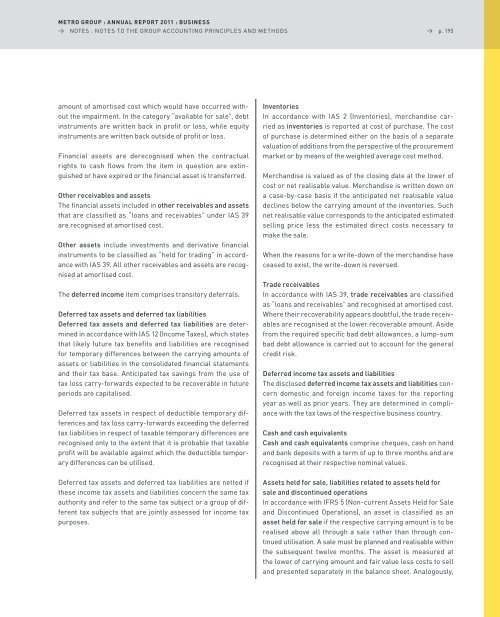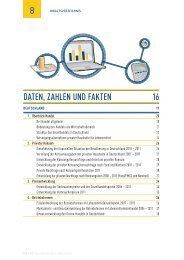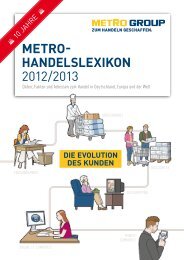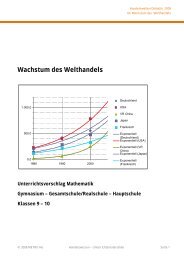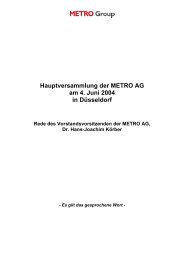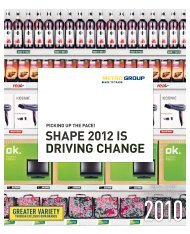pdf (22.8 MB) - METRO Group
pdf (22.8 MB) - METRO Group
pdf (22.8 MB) - METRO Group
Create successful ePaper yourself
Turn your PDF publications into a flip-book with our unique Google optimized e-Paper software.
<strong>METRO</strong> gROUP : ANNUAL REPORT 2011 : BUsiNEss<br />
→ noTes : noTes To THe GRoUp aCCoUnTInG pRInCIples anD MeTHoDs<br />
amount of amortised cost which would have occurred without<br />
the impairment. In the category “available for sale”, debt<br />
instruments are written back in profit or loss, while equity<br />
instruments are written back outside of profit or loss.<br />
Financial assets are derecognised when the contractual<br />
rights to cash flows from the item in question are extinguished<br />
or have expired or the financial asset is transferred.<br />
Other receivables and assets<br />
The financial assets included in other receivables and assets<br />
that are classified as “loans and receivables” under Ias 39<br />
are recognised at amortised cost.<br />
Other assets include investments and derivative financial<br />
instruments to be classified as “held for trading” in accordance<br />
with Ias 39. all other receivables and assets are recognised<br />
at amortised cost.<br />
The deferred income item comprises transitory deferrals.<br />
Deferred tax assets and deferred tax liabilities<br />
Deferred tax assets and deferred tax liabilities are determined<br />
in accordance with Ias 12 (Income Taxes), which states<br />
that likely future tax benefits and liabilities are recognised<br />
for temporary differences between the carrying amounts of<br />
assets or liabilities in the consolidated financial statements<br />
and their tax base. anticipated tax savings from the use of<br />
tax loss carry-forwards expected to be recoverable in future<br />
periods are capitalised.<br />
Deferred tax assets in respect of deductible temporary differences<br />
and tax loss carry-forwards exceeding the deferred<br />
tax liabilities in respect of taxable temporary differences are<br />
recognised only to the extent that it is probable that taxable<br />
profit will be available against which the deductible temporary<br />
differences can be utilised.<br />
Deferred tax assets and deferred tax liabilities are netted if<br />
these income tax assets and liabilities concern the same tax<br />
authority and refer to the same tax subject or a group of different<br />
tax subjects that are jointly assessed for income tax<br />
purposes.<br />
→ p. 195<br />
Inventories<br />
In accordance with Ias 2 (Inventories), merchandise carried<br />
as inventories is reported at cost of purchase. The cost<br />
of purchase is determined either on the basis of a separate<br />
valuation of additions from the perspective of the procurement<br />
market or by means of the weighted average cost method.<br />
Merchandise is valued as of the closing date at the lower of<br />
cost or net realisable value. Merchandise is written down on<br />
a case-by-case basis if the anticipated net realisable value<br />
declines below the carrying amount of the inventories. such<br />
net realisable value corresponds to the anticipated estimated<br />
selling price less the estimated direct costs necessary to<br />
make the sale.<br />
When the reasons for a write-down of the merchandise have<br />
ceased to exist, the write-down is reversed.<br />
Trade receivables<br />
In accordance with Ias 39, trade receivables are classified<br />
as “loans and receivables” and recognised at amortised cost.<br />
Where their recoverability appears doubtful, the trade receivables<br />
are recognised at the lower recoverable amount. aside<br />
from the required specific bad debt allowances, a lump-sum<br />
bad debt allowance is carried out to account for the general<br />
credit risk.<br />
Deferred income tax assets and liabilities<br />
The disclosed deferred income tax assets and liabilities concern<br />
domestic and foreign income taxes for the reporting<br />
year as well as prior years. They are determined in compliance<br />
with the tax laws of the respective business country.<br />
Cash and cash equivalents<br />
Cash and cash equivalents comprise cheques, cash on hand<br />
and bank deposits with a term of up to three months and are<br />
recognised at their respective nominal values.<br />
Assets held for sale, liabilities related to assets held for<br />
sale and discontinued operations<br />
In accordance with IFRs 5 (non-current assets Held for sale<br />
and Discontinued operations), an asset is classified as an<br />
asset held for sale if the respective carrying amount is to be<br />
realised above all through a sale rather than through con-<br />
tinued utilisation. a sale must be planned and realisable within<br />
the subsequent twelve months. The asset is measured at<br />
the lower of carrying amount and fair value less costs to sell<br />
and presented separately in the balance sheet. analogously,


